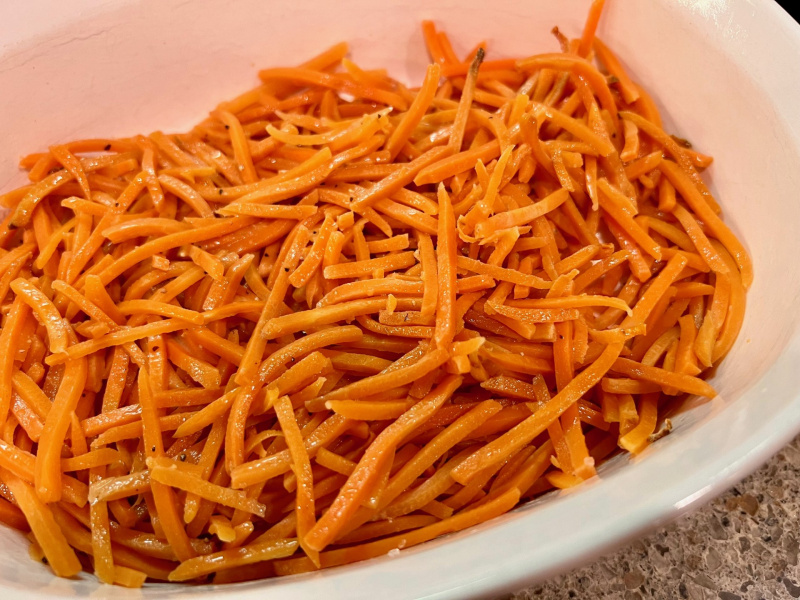What’s not to love about glazed carrots? My family loves them, and we’ve been making the version from our Joe Beef cookbook, published by the chefs at the inimitable French bastion of beef in Montreal. Our summer evening at a table on their screened-in porch was one of the best meals of our lives, certainly.
So I gave Margaret Harness’s “Baked Glazed Carrots” recipe a try. And it was great!
Barely A Process
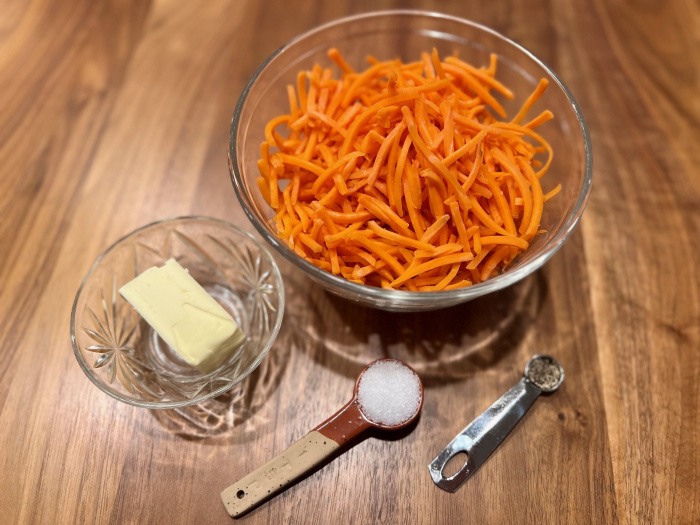
I can see why this recipe appealed to or was created by Margaret Harness. It takes barely any time to put together. And if you have shredded carrots from the grocery store, like I did, it’s the fastest dish in the world, even if the Joe Beef staff would not approve. Derisively, they exhort you to “use anything but the dreary, bagged mini carrots carved from larger, less valuable specimens (they have more in common with sea monkeys than food). It’s simple: if the carrots look shitty that day, buy spinach. If not, cook them up like this” (198). Declaratives with that level of confidence make me want to find some heirloom carrots immediately.
Though it felt a bit strange to add only carrots with no seasonings or liquid, as instructed in bold font with an exclamation point, I put three cups of shredded carrots in a casserole dish (was it tightly covered enough, though? I don’t have a tight-fitting casserole lid, I don’t believe. I settled for placing my casserole dish’s lid in its typical location).
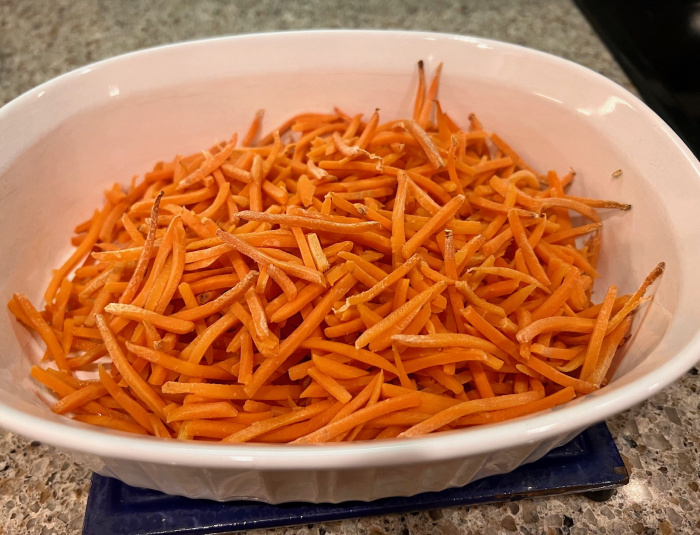
In the oven, it joined a scalloped corn casserole I was baking for “Vintage Dishes,” my monthly column in the Fargo Forum. After reading about eminent food critic and writer M.K. Fisher’s conservation methods detailed in her book How to Cook a Wolf, in a fantastic essay by Abby Walthausen, I’ve been even more mindful of making my appliances do double duty when it’s possible https://electricliterature.com/this-cookbook-from-1942-is-the-conservation-guru-we-all-need/).
Baking the carrots with the corn meant that the dish baked at a slightly higher temperature than the recipe recommends—350, rather than 325˚, but I took the carrots out early—after twenty minutes—to check whether they were tender. They were, and so I proceeded to finally add the accoutrement I so desired these carrots to have: three tablespoons of butter, salt, and pepper.
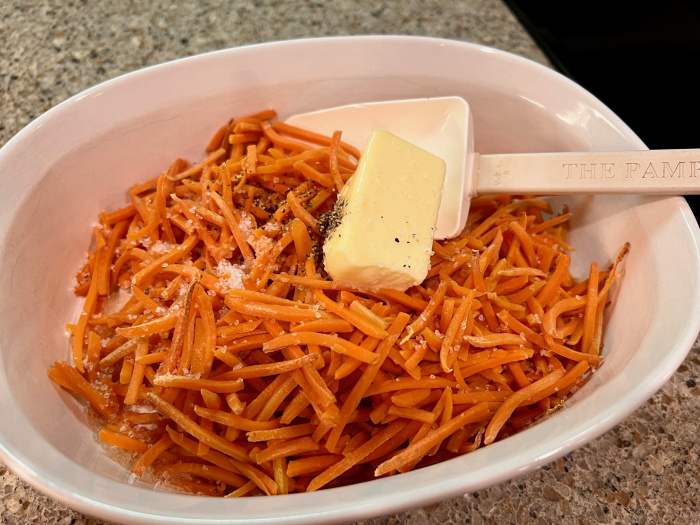
Reflections
Glistening in the dining room light, these carrots looked lovely as I transferred them to our plates to accompany our chicken and homemade buns (post coming soon!).
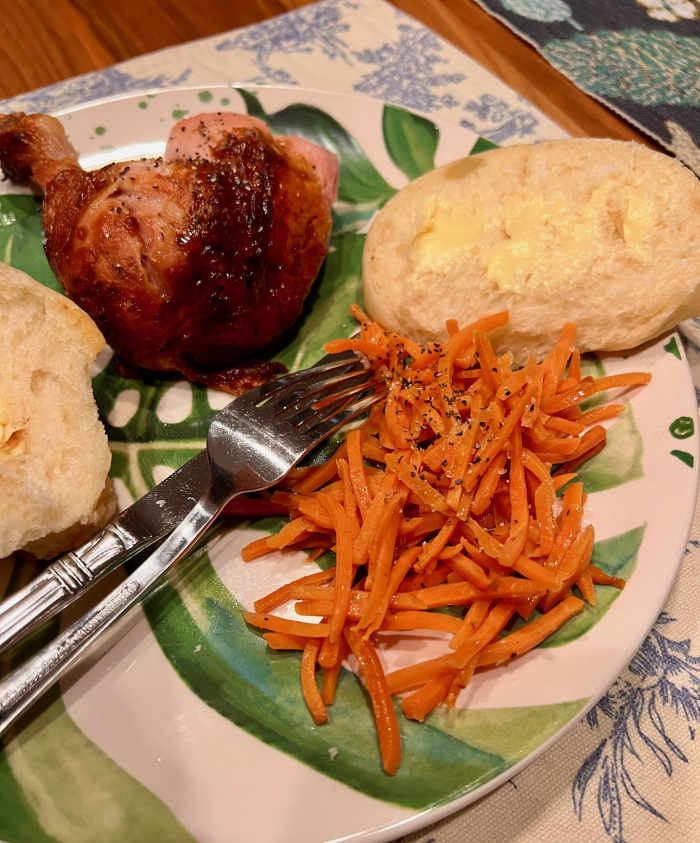
They were tender, buttery, and rich, almost candied. That’s because carrots are “notably sweet,” in Harold McGee’s terminology in his always astute On Food and Cooking: The Science and Lore of the Kitchen (306). Sweetness is a flavor “most noticeable when the roots are cooked, which weakens the strong cell walls and frees the sugars to be tasted” (McGee 307). but much too salty, we all thought. I like salt, a lot, but wow, was one teaspoon of salt way too much for three cups of shredded carrots. I would drop it to half a teaspoon or would double the amount of carrots. I would also increase the pepper to at least a quarter teaspoon.
I’ll make this again, as it’s a great way to provide a warm vegetable side on a busy weeknight. It really couldn’t be simpler.
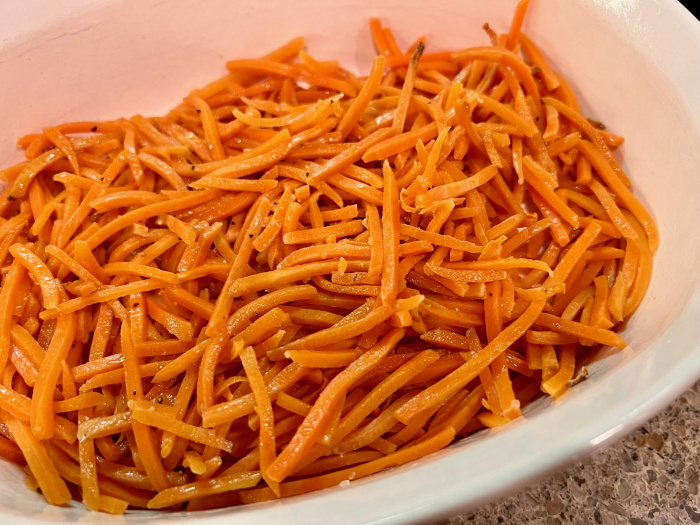
Contributor: Margaret Harness
Margaret Thompson was born in March 1917, the oldest of the five children of Oscar and Mena (Oslie) Thompson. In 1935, she graduated from Velva High School as valedictorian, and after a business course in Minot, she worked at the McHenry County ASC office in Towner between 1937 and 1944. In 1944, Margaret enlisted in the U.S. Navy and was stationed in the Disbursing Office at NAS Alameda in California. Honorably discharged in 1946, at home, Margaret worked for the Krebsbach Company as their bookkeeper prior to marrying Emil A. Harness in 1949. Born in 1910, to Ole and Otilda (Bramer) Harness, Emil was born in North Prairie Township on his family farm, and after serving in the army in the Panama, he returned to the Velva area and took over the farm. After their marriage, Emil and Mary farmed until retiring in 1975. The couple had two children, Mark and Mary, about whom you can read in a previous post about a delicious chicken tortilla casserole (see https://blog.cord.edu/karlaknutson/2024/09/06/a-playdate-luncheon-irmas-chicken-tortilla-casserole/). Late in their retirement, Margaret and Emil moved to Velva in 1992. Emil passed in 1995; Margaret in 2011.
Family networks of the members of Oak Valley Lutheran Church are threaded through The Joy of Sharing. I’ve previously written about and made recipes by not only Margaret’s daughter Mary, but also her younger sister, Lorraine Thompson, who was a favorite elementary teacher of my father (see https://blog.cord.edu/karlaknutson/2023/06/27/aunt-ellens-carrots/). The post about Lorraine also shares more about Lorraine and Margaret’s maternal grandparents, Andreas and Mathea (Korsveen) Oslie, as they immigrated from Norway to the United States, Concordia connections (the sisters’ younger brother Jerome attended Concordia, as did Margaret’s daughter Mary), and the many members of this family who contributed to the cookbook, comprising four generations as of 1985.
Margaret’s other contributions to The Joy of Sharing are “Peach Kuchen,” “Minted Nuts,” “Zippy Microwaved Potatoes,” and “Rhubarb Jam.”
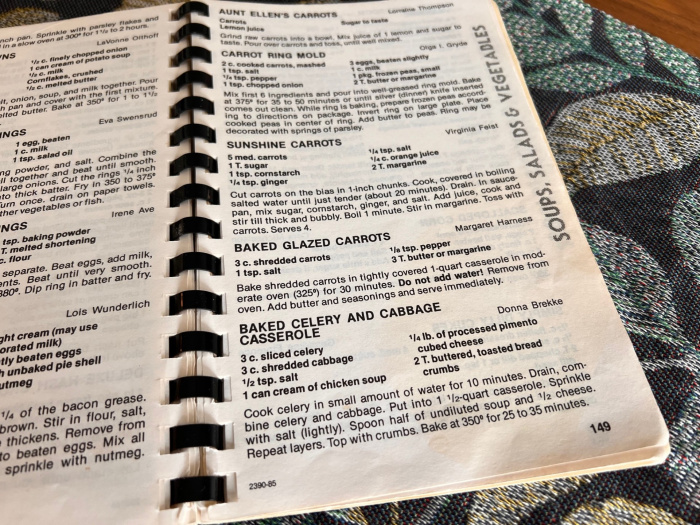
This post is part of an ongoing series in which I make and reflect on recipes and the people who contributed them to the 1985 Oak Valley Lutheran Church compiled cookbook, The Joy of Sharing.

